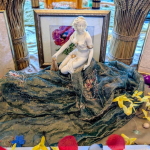One of the biggest issues that people seem to have with godslavery, over and above the apparent lack of agency, is that to many, it implies the Gods are cruel, capricious, even sociopathic. My own experience of Odin, even at the harshest point of ordeal has been anything but. Yes, He can be merciless. All the Gods can be (read the lore, if you doubt that). But He can also be passionately loving, and He is, most especially when He is asking His people to do that which is most painful. I would caution against casting human mores onto the Gods: They are rarely if ever cruel for cruelty’s sake. What we interpret as harshness may be anything but; it may be the deepest expression of loving kindness on the part of the Deity in question: I know my ordeals were; and I know other godatheow who would say the same.
In other venues, I have written extensively about Ordeal work, and often I talk about the dynamic of submission, particularly the use of pain as a tool in this process. The ongoing argument against godatheow tends to be twinned with a great hostility toward ordeal work (even though not every godslave is an ordeal worker). In both cases, it is the loss of personal agency involved that creates the conflict. The submission to pain as an act of personal empowerment raises many questions not only about the nature of pain but also about the nature of personal agency. A clear distinction must be drawn between “pain as a cause of action,” and “pain as a kind of action.”(1) It is this latter manifestation of pain encompassed by Odin’s story. Here, pain is used not as an externally repressive measure, but as an expression of personal sovereignty.(2) Anthropologist Talal Asad notes that ‘when we say that someone is suffering, we commonly suppose that he or she is not an agent. To suffer…is, so we usually think, to be in a passive state – to be an object, not a subject.”(3) In Odin, however, the reader is presented with the image of a suffering body engaged in an act of power, or, as modern ordeal workers might phrase it: ‘hunting for power.”(4) In such a context, pain loses its emotional charge and becomes a consciously applied tool in a greater process of development. Pain becomes something more than a private experience, or an experience of utter loss of control. It becomes an act of power, one that sets the defining tone for an entire religious tradition. Of course, to those outside of this dynamic, accepting the fact that either godslavery or ordeal can be a holy act means completely re-examining everything we think we know about the Gods.
The Gods are real. They are not manifestations of one’s unconscious. They are not archetypes. They are not imaginary beings. They are real. They have personalities, likes, dislikes, will. Oh boy do They have will! What’s more, They aren’t always nice. Not only can They act in ways that might be interpreted as non-consensual, They often do. Many people, even (perhaps most especially godslaves) struggle terribly with this potential for non-consensuality. This may not be the way it works for everyone, but there are Deities (like Odin) who won’t hesitate a moment to force Their will on those who are lawful prey to Them. Can one back out? Sure. But the price is often much greater and much worse than one is willing to pay. It’s not a matter of “safe, sane, consensual,” or of “risk aware consensual kink,” though I have found that BDSM terminology can be very helpful from a psychological standpoint in coming to comprehend the type of relationship one might find oneself in with one’s Gods. It goes well beyond such neatly defined territory. I believe our ancestors would have understood this well.
At the same time, I think that the question of consensuality is a rather grey area, a keenly balanced knife’s edge upon which the spiritworker walks: I say I’m a godslave because I’m owned and to Him and Him alone do I place myself in thrall, but Odin gave me a chance to run away from it years ago. I chose not to take it. I cannot say He wasn’t fair: He did give me one chance. So how much of the bondage is my own personal agency and consent, and His will? I don’t know. It doesn’t matter. What matters is that so long as I’m not stupid enough to render myself useless to Him, that bond is now irreversible (on my end at least).
Happily, there is slowly starting to be more discussion about the various manifestations of the Deity/servant relationship. Silence Maestas put out a book called ‘Walking the Heartroad” by Asphodel Press that discusses at least half a dozen, if not more variations in the ways that Gods can interact with their servants. It may be that for some of us the godatheow pattern is the most common, but that doesn’t mean it’s the only one. Even within my own relationship with Odin, it’s not *just* that, we relate on a plethora of levels. He is my Master, Teacher, Beloved, my Lord (though at the bottom, deepest level, when all else is stripped away, it is Master/slave). For me, this is incredibly fulfilling. I am closer to Him than I ever thought possible precisely because I was able to accept being bound as His godatheow. I wouldn’t have it any other way. I’m well aware, however that for someone else, being bound in such a fashion might actually hinder and harm them in their spiritual Work. This is why I say: leave it in the hands of the Gods. They know us better than we know ourselves.
I think that prevailing idea that A) the Gods are all sweet and nice and B) that They’d never force us to do anything are two of the most damaging ideas within Paganism. They’re also ideas that I think our ancient forebears would find laughable and quite possibly dangerous and unlucky. There is nothing safe about this work. Nor is there anything safe about the sacred. I think our ancestors understood that far, far better than people do now. But we’re learning, slowly but surely, we’re learning.
Footnotes:
1. Talal, Asad, (2003). Formations of the Secular. California: Stanford University Press, p. 69.
2. Asad, p. 71.
3. Asad, p. 79.
4. Krasskova, currently unpublished article “Ordeal Work, Body Modification, and the Use of Pain in Modern Norse Paganism.” First presented October 4, 2008 at a religious studies conference at Ohio State University.













